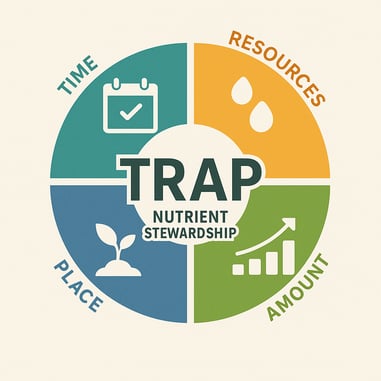Reevaluating the 4R’s: Why Growers Need a Better Nutrient Stewardship Framework
by Douglas Amaral @ University of California Cooperative Extension


Efficient nutrient management is critical to maximizing crop yield and quality while minimizing environmental impact. For years, growers have relied on the 4R’s of nutrient stewardship (Right Source, Right Rate, Right Time, and Right Place) as the guiding principles to optimize fertilizer use. While the 4R's framework provides a solid foundation, it is a bit abstract, and all the "Right" repetition doesn’t make it easy to remember what actually needs to happen hindering widespread adoption and practical implementation on many farms.
Limitations of the 4R’s Framework
The core challenge with the 4R’s lies in the ambiguous use of the word “Right.” The 4R's are too vague, and hard to communicate, especially to farmers who want straightforward, actionable advice. Repeating the word “Right” four times does not help anyone remember what actually needs to be done. This ambiguity often makes the framework difficult to translate into specific, actionable steps for growers.
Additionally, the 4R’s framework traditionally focuses on synthetic fertilizer inputs, often overlooking other significant nutrient resources such as organic amendments, manures, irrigation water, and cover crops. This omission limits the framework’s relevance in integrated nutrient management systems, particularly in diversified or regenerative operations.
Introducing “TRAP”: A Practical Framework for Nutrient Management
The TRAP framework (Time, Resources, Amount, Place) offers a simplified, yet comprehensive approach tailored to the practical needs of growers. By clarifying the core components of nutrient stewardship, TRAP enables growers to make precise, site-specific decisions that improve nutrient use efficiency and crop performance as follows:
Time: Nutrient availability must coincide with critical crop growth stages for optimal uptake. Applying nutrients when plants are physiologically ready to absorb them, reducing losses from leaching, volatilization, or runoff is essential.
Resource: A key improvement in TRAP is the broad definition of Resources. This category includes not only synthetic fertilizers but also organic amendments (e.g. manure, compost), irrigation water containing nutrients, cover crops, and biological inputs like biofertilizers. A comprehensive accounting of all nutrient sources is essential to avoid over-application, optimize nutrient cycling, and reduce input costs.
Amount: Determining the optimal nutrient amount requires integrating soil and water test results, crop nutrient uptake data (nutrient budget), and contributions from all resources. It will guide growers to calculate net nutrient requirements, enabling precise applications that meet crop demands without excess.
Place: Correct placement of nutrients maximizes root access and improved nutrient use efficiency. Proper placement also helps reduce nutrient losses to groundwater and surface water bodies.
TRAP your nutrients where they belong – in the soil!
TRAP provides a clear, actionable framework that integrates diverse nutrient sources and management practices, making it more relevant to today’s complex farming systems. Its simplicity aids in communication and training, while its focus on practical decision points aligns with growers’ day-to-day challenges.
While the 4R’s laid the groundwork for nutrient stewardship, TRAP refines and expands the approach to better meet growers’ needs. It offers a practical, technically sound framework that promotes smarter, more integrated nutrient management decisions. For growers committed to optimizing inputs and protecting their land, adopting TRAP is a strategic step forward.
